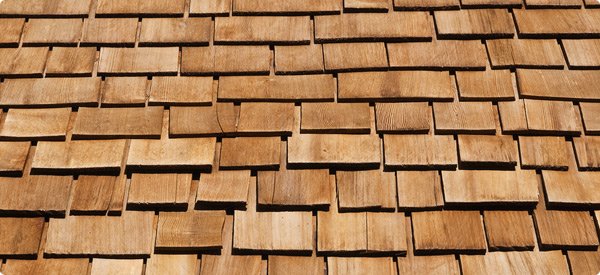Roofing in Denver is a serious business because of the high number of wind and hail storms that occur in the Front Range every year. Hail damage roof inspections are a daily part of the job for Denver roofing contractors. When Denver roofers inspect hail damage on roofs, they are looking for damage to the shingles. When it comes to wood shingles and shake roofs, the roof inspector counts the number of hail hits per shingle and they look for splits in the wood shingle.
First of all, wood shingles and shake roofs hold up really well when hit by hail, as long as the wood shake shingles did not split upon impact. If the wood shingle is not immediately split by a hailstone, it will probably remain intact. To see hail damage on wood shingles, look for a hail impact mark on or near a fresh split in the wood. In general, small hailstones do not do enough damage to wood shingles or shakes to cause a significant change in the shake roof functionality or structure.
Wood Shake Hail Damage
After a major hail storm, the damage is immediately apparent on a wood shake shingle. However, if you wait to get a hail damage roof inspection, the shake damage won’t be as obvious as it is right after a hail storm. The reason is the insurance roof adjuster may classify the damage as “natural shake weathering” instead of roof hail damage if enough time has passed after the hail storm.
Wood shingles are highly resilient to hail damage, and even with a few cracks and splits, the function and performance of the shake roof are maintained. However, if wood shakes are severely cracked, the felt water barrier underneath the shingle becomes compromised and eventually allows water to seep through the roof and into the structure. It may take years for leaks to show up. This is one reason why it’s very important to get a hail damage roof inspection right after a hail storm so the insurance adjuster can determine that cracks and splits are caused by hail damage and not by natural shake weathering.
Wood Shake Coloring

A typical wood shake shingle is red on the inside and gray on the outside. The gray is caused by natural weathering and oxidation of the wood. When a wood shingle splits, you can see the red color of the wood on the inside of the shingle, and if the split has been there a long time, the inside of the shingle changes from red to gray. If you have a wood shake shingle roof and if any of the shingles have come loose and fallen to the ground, compare the inside color of the wood with the outside color. If the wood shingle is fully gray, it needs to be replaced.
Types of Wood Shake Damage
Wood shake shingles and shake roofs are a small but significant part of the roofing market, and wood shingles are covered by insurance claims for hail damage to roofs. How do you tell if the hail damage on roof is only cosmetic or if it the performance of the wood shingle is compromised? This is a question for a qualified Denver roof inspector to answer.
Cosmetic damage looks like dents and splatter marks on the wood shingle. This does not affect the performance of the wood shake shingle, but it does indicate the roof has experienced a hail storm event that could have damaged the roof. Cosmetic damage does not require a roof replacement unless the damage reduces the roof performance. Individual wood shake shingles can be replaced if you want to eliminate the cosmetic issue.
Hail damage that affects the performance of the roof looks like a hail strike that causes a fresh split in the unsupported part of the wood shingle. A new shake shingle can withstand a hail strike from up to a 2-inch piece of hail, but a badly weathered shake shingle can split and crack from a ¾ inch piece of hail. If the wood shake shingles are badly weathered and a big hail storm hits, it is likely the roof will need to be replaced.

Peak to Peak Roofing has a team of qualified Denver roofing contractors who are ready to visit your home or business to do a free hail damage roof inspection. No matter what type of roof you have, Peak to Peak Roofing will provide expert advice about what is best for your property. Contact us today to schedule an onsite visit.

